 |
|
|||
 |
 |
|||
Copyright © Harry Rinker, LLC 2016 Questions
and Answers
QUESTION: I recently came across a Deutschland Erwache flagpole finial. The central feature is a wreath with a swastika in the center. A spread-winged eagle sits atop the wreath. The unrestored piece is missing most of its silver and gold plating. Through my research, I found that Otto Gahr initially produced four Deutschland Erwache flagpole finials in 1923 and more were mass-produced after that. Is there any way to tell the difference between the first four and the others? I know the example I own being one of the original four is a long-shot, but I figured I would ask. I have been told that in this condition its value would be around $10,000.00 to $12,000.00, but I really do not know who to trust. How can I best sell it to achieve its maximum value? –AT, Buffalo, NY, Email Question 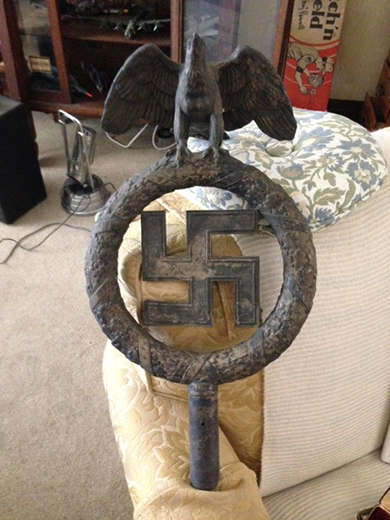
ANSWER: I am assuming that the ownership provenance of the Deutschland Erwache flagpole finial has been lost over time. My suspicion is a “sticky finger collectible” brought home by a GI who served in Germany during or immediately after World War II. It also might have entered the collectible marketplace through catalog firms, such as Bannerman’s, who sold obsolete and abandoned military equipment. Otto Gahr was a silversmith favored by the Nazi elite. He is recognized for his “death’s head” rings made for SS members. He is best known for his design for the Chiemsee Cauldron, a 10-kilogram gold cauldron manufactured in the workshop of Theodore Helden, a Munich jewelry manufacturer. 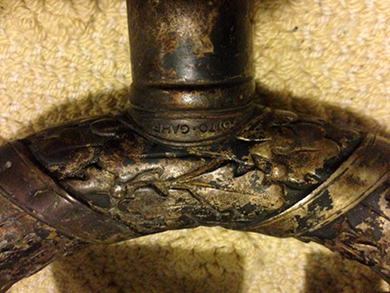
Chances of you owning one of the “initial” four finials is zero. What you own is one of the mass-production examples of the 1923 Otto Gahr design. The stock photo website www.alamy.com offers numerous images of this flagpole finial. The eagle is gold gilded as are the bands around the silvered wreath. There were many variations of this flagpole finial and its eagle. “Deutschland Erwache” by Ulric of England and Otto Spronk, published by R. James Bender Publishing in May 1997, pictures several of them. Although the survival rate may be small, there are examples available in fine or better condition. Admittedly, some may be restored. The secondary market is fluid. I did find examples in fine condition listed for over $10,000.00. Each was in C8 or better grade condition. Once a seller is aware of high numbers, it is hard to imagine his/her example is worth less. There were no records for C3 to C5 examples, most likely because there is little to no market for them. Condition is critical to value. At best, your example is in restorable condition, meaning it has to be sand blasted, re-silvered, and re-gilded. Collectors will not accept amateur restoration. Restoration has to be done by a professional. Selling German National Socialist material is problematic. Many selling sources such as eBay prohibit listing “Nazi” material. There are more than a dozen specialized internet sellers, such as www.oakleafmilitaria.com, you might consider approaching. Some gun websites allow the sale of material. You will achieve the best price if you can find an auction source. If you do opt for the auction route, make certain the auctioneer reaches an international market and takes online bids. The strongest market for the Deutschland Erwache flagpole finial is Germany. If the person who told you it was worth over $10,000.00 was serious, ask him to “put the money where his mouth is.” Offer it to him for $5,500.00. If he accepts, sell. You have the money. He has the problem of what to do next. What is my estimate of the flagpole finial’s secondary market value? Given its condition and my conservative approach to value, its secondary market value is between $1,250.00 and $1,750.00. Please email me and let me know how you disposed of the Deutschland Erwache flagpole finial and what price you did achieve. QUESTION: I have a KA-BAR Marine issue military fighting knife in its leather sheath. It is in very good condition. What is it worth? – KT, Email Question 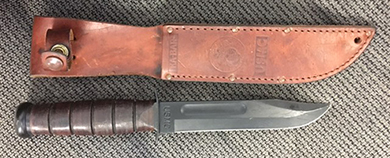
ANSWER: KA-BAR still produces a straight edge military knife identical to the USMC KA-BAR knife you own. It sells for $98.36. KA-BAR submitted a design for a general issue combat knife to the United States Marine Corps in late 1942. After receiving critiques from the Marine Quartermaster Department, the design was revised. Production began. The combat knife was universally acclaimed by the Marines who used it. Within a short period of time, the Army, Coast Guard, Navy, and Underwater Demolition Teams adopted the knife. Besides World War II, the knife saw service in Korea, Vietnam, Desert Storm, and the Iraq conflict. The USMC KA-BAR knife also was produced for civilian use. Adventurers, outdoor sportsmen, survivalists, and others use it as their personal knife. Blade variations are available. At the time the knife was designed, KA-BAR was a brand of the Union Cutlery Company of Olean, New York. The knife’s popularity resulted in the company changing its corporate name to KA-BAR Cutlery in 1952. For a detailed history of KA-BAR and its combat knife, see: https://en.wikipedia.org/wiki/Ka-Bar. The survival rate for World War II USMC KA-BAR combat knives is high. Given the knife’s long production history, it is critical to establish a clear line of ownership proving the knife was manufactured prior to 1946. Examples abound on eBay. Asking prices for examples in fine or better condition start around $125.00 and can exceed $200.00. These are asking prices, not getting prices. Further, there appears to be little value difference between knives used by the different military branches. QUESTION: I have a framed print entitled “Waiting for the Master.” It pictures two dogs—a seated terrier and a hound resting on the floor. “Supplement of The Philadelphia Inquirer Copyright 1900” is in the left corner. “Chicago / Color TY” is in the right corner. The print hung on the wall at the home of my Great Aunt, who died at age 101 in 1987. Does it have any value beyond its sentimental value to the family? – SM, Reading, PA, Email Question 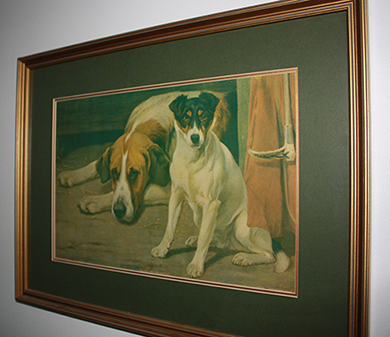
ANSWER: It was a common practice during the first decades of the twentieth century to provide frameable pictures as a bonus feature in Sunday papers. The prints were colorful. The principle problem is that they were printed on lesser quality paper, meaning that they often became brittle. The supplements were supplied by stock houses. Chicago was a major source for stock prints used for advertising, calendars, and supplements. Attempts to identify the artist failed. Researching the title resulted in a wide variety of subject themes including religious, fraternal, and animals, primarily dogs. In respect to dog images, there were more than a dozen variations Dog collectors are breed specific. A collie collector has little interest in an image of a fox terrier. Hence, the value of your print depends heavily upon finding someone who cares about the dog breeds that appear in it. Further, the image is maudlin and dated, meaning that the print’s appeal to younger collectors is weak. If someone offered $25.00, my advice would be to take it. I hope the print’s sentimental value is greater than this. Be forewarned. When the individuals who remember your Great Aunt pass away, the print’s sentimental value will be lost. Until then, look at it, smile, and remember. QUESTION: I have a Royal Doulton “Penelope” figurine. Normally, Royal Doulton figurines have an HN number. Mine does not. I am certain it is a mass-produced piece. What is my example worth? – KD, Commerce Township, MI, Email Question 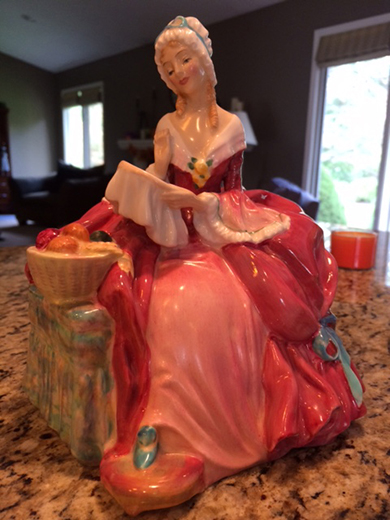
ANSWER: Your Royal Doulton “Penelope” figurine is number HN 1901. From time to time, a figurine slips through the production line with one or more of the backstamps missing. A missing backstamp does not increase the object’s value. “Penelope” is a common Royal Doulton figurine. There are numerous “Buy It Now” listings for the figurine on eBay. Values begins around $135.00 and can exceed $270.00. Of course, it is hard to imagine why anyone would pay $270.00 when he/she can buy an identical example for half the price. “Buy It Now” prices are asking prices. Exercising a “Best Offer” option most likely would result in a sell price of around $100.00. The Royal Doulton figurine secondary market was hard hit by the 2008-2009 Great Recession. Prices are depressed and not likely to increase anytime soon. A realistic secondary market value for your figurine is between $75.00 and $90.00, far less than it sold for as new. 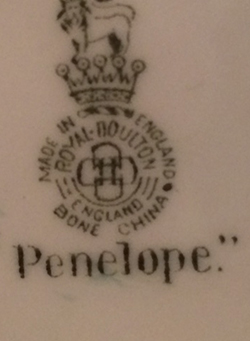
Harry L. Rinker welcomes questions from readers about
collectibles, those mass-produced items from the twentieth and twenty-first centuries.
Selected letters will be answered in this column.
Harry cannot provide personal answers.
Photos and other material submitted cannot be
returned.
Send your questions to: Rinker on Collectibles, 5955 Mill
Point Court SE, Kentwood, MI 49512.
You also can e-mail your questions to
harrylrinker@aol.com.
Only e-mails containing a full name and mailing address
will be considered.
You can listen
and participate in
WHATCHA GOT?, Harry’s
antiques and collectibles radio call-in show, on Sunday mornings between 8:00 AM
and 10:00 AM Eastern Time.
If you
cannot find it on a station in your area,
WHATCHA GOT?
streams live on the Internet at www.gcnlive.com.
SELL, KEEP OR TOSS?: HOW TO DOWNSIZE A HOME,
SETTLE AN ESTATE, AND APPRAISE PERSONAL PROPERTY
(House of Collectibles, an imprint of Random House Information Group, $17.99),
Harry’s latest book, is available at your favorite bookstore and via
www.harryrinker.com.
|
||||